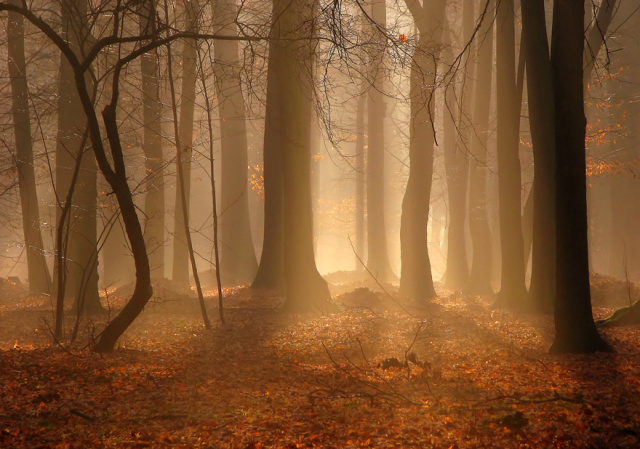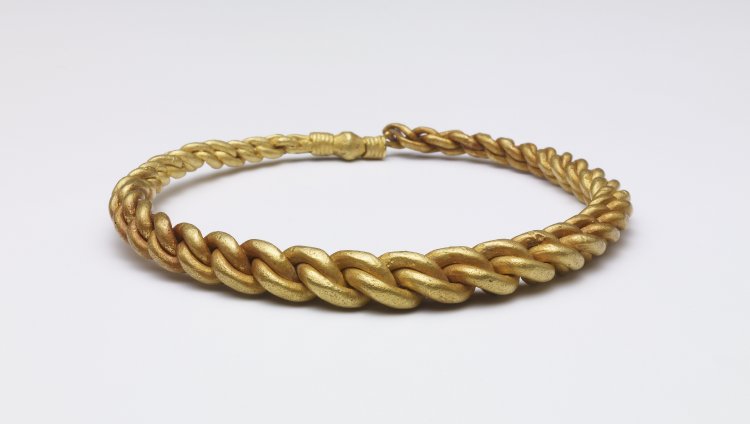
In late December 999 AD Brian Bóruma, king of Munster, decisively defeated the Vikings of Dublin[i] at the battle of Glen Máma[ii]. This bloody contest was a severe set-back for the Hiberno-Norse inhabitants of the city, and their king, Sitric Silkbeard, was forced to flee. The following day Brian’s troops marched on Dublin, which they entered uncontested, plundering and burning as they went. However, somewhat unusually, Brian diverted a section of his forces to a forest close to the city. Here they proceeded to cut and burn the trees of Caill Tomair, in an act that was deemed worthy of being recorded in the Irish Annals[iii].
The etymology of Caill Tomair may give an insight into why Brian carried out this unusual manoeuvre. It appears to be made up of the Irish word for a forest/wood (coill) and an Irish rendering of the divine name Thor (Þórr), literally Thor’s Wood[iv]. If this interpretation is correct then it suggests that the site was probably a sacred grove where the pagan inhabitants of Dublin worshipped Thor[v] . If this was the case then its destruction was an act imbued with both religious and political symbolism and a very clear assertion of Brian Bóruma’s dominance over the newly captured city.

Sacred groves played an important part in Norse pagan religious practice and were normally referred to as lundr in Old Norse. These sites appear to have been relatively common and were often incorporated in later Scandinavian place-names. For example Þórs lundr (Thor’s Grove) is a common place-name in Denmark.
The most famous surviving description of a sacred grove comes from an 11th century account by Adam of Bremen, which details the temple site at Gamla Uppsala in Sweden. In it he states that ‘near the temple is a sacred grove which each and every tree is sacred and in which the human and animal victims are hanged’[vi]. This appears to describe the Norse pagan practise of blót , which involved sacrificing animals and sometimes humans, to appease the gods. This ritual was often associated with sacred groves and it is possible that it was also carried out at Caill Tomair in Dublin.

The dedication of the Dublin grove to Thor is not surprising as this deity was one of the most popular Nordic gods. Associated primarily with thunder and fertility, his adherents often wore miniature Thor’s hammers in attempt to invoke his favour. A number of these small hammers are known from Viking Age Dublin and it appears that the city’s residents may have had a special affinity with the thunder god. This is suggested by a number of early Irish texts, which refer to Dublin’s inhabitants as ‘Muintir Tomar’[vii], which probably translates as ‘Thor’s people’.
Furthermore, one of the city’s main pieces of regalia during the 10th century was an object known as ‘Fail Tomar’[vi] or ‘Thor’s Ring’. This item, which was captured by Máel Sechnaill mac Domnaill, king of Mide, in 995 AD, may have been a heathen cult object similar to the Thor’s ring described in the Kjalnesinga Saga. This Icelandic text describes a large ring, which was located within a temple dedicated to Thor. ‘On the altar was to lie a great armband, made of silver. The temple priest was to wear it on his arm at all gatherings, and everyone was to swear oaths on it whenever a suit was brought’[ix]. The use of this Thor’s ring in oath-swearing ceremonies mirrors contemporary Irish society where saint’s relics were often used for pledging oaths and making legal treaties.

Thor’s hold on Dublin was soon to wane, however, and in the early 11th century the city officially became a Christian one. In 1028 its king, Sitric Silkbeard, formally established the diocese of Dublin and Dúnán was ordained the city’s first bishop. Construction also commenced on Christchurch Cathedral and this soon became the focal point of religious practice within the city walls. The citizens of Dublin, it seems, were no longer the people of Thor.
[i] The army facing Brian and his ally Máel Sechnaill mac Domnaill, king of Mide, was a combined force of Dublin Vikings and Leinster men under the command of Máel Mórda mac Murchada
[ii] For a detailed description of the battle see MacShamhráin, A. ‘The battle of Glen Máma, Dublin’in Sean Duffy (ed.) Medieval Dublin II, Dublin, pp. 53-64
[iii] Annals of Innisfallen (Corpus of Electronic Texts, U.C.C., accessed 11-07-13)
[iv] See Downham, C. ‘Religious and Cultural boundaries between Vikings and Irish: The Evidence for conversion‘ & Sayers, W. 1991. ‘Clontarf, and the Irish Destinies of Sigurdr Digri, Earl of Orkney, and Porsteinn Sidu-Hallsson’ in Scandinavian Studies (Spring 1991), p. 176, for discussion
[v] It is also possible, though less likely, that Tomair represents a corruption of a Norse personal name
[vi] Adamus Gesta Hammaburgensis ecclesiae pontificum (accessed 11-07-13)
[vii] Annala Rioghachta Eireann: Annals of the Kingdom of Ireland by the Four Masters, ed. and trans. John O’Donovan, second edition, 7 vols (Dublin: Hodges, Smith, 1856), II, 652-53. & Lebor na Cert: The Book of Rights, ed. and trans. M. Dillon (Dublin: Irish Texts Society, 1962), p. 10 (after Downham, C. ‘Religious and Cultural boundaries between Vikings and Irish: The Evidence for conversion’)
[viii] Chronicon Scotorum CS995 (Corpus of Electronic Texts, U.C.C., accessed 11-07-13)
[ix] Porter, J. 1997. ‘The Saga of the People of Kjalarnes’ in Vidar Hreinnson et all (eds.) The Complete Sagas of Icelanders, Reykjavik. p. 307



Is the Sitric Silkbeard of 1028 the same one that fled in 999? He was allowed to regain the throne? This is an interesting bit of history, I’ll have to look this up.
It’s the same guy all right Nic. He was allowed back after submitting hostages to Brian and pledging allegiance. This didn’t stop him rebelling again though and his forces also fought against Brian at the Battle of Clontarf in 1014. Despite losing this battle Sitric still managed to hold on to power in Dublin. A resilient character by all accounts.
Well, this turns a twist on the Boru – Viking saga, which is revelled by the Irish as a national victory.
The symbolism of destroying a sacred forest and building a Christian Cathedral in it’s place seems to tell another tale.
However, even the Norse men eventually became the cathedral builders after they burned their ships at Normandy and took to the land and concept of ownership.
Does the place-name of Thor’s Wood exist? It is said to be outside the city while the site of Christ Church is inside the city.
It doesn’t exist anymore Niall. The original site of the wood is uncertain, but it was definitely outside of city’s boundaries/walls. Some have suggested that it may have been located on the northside of the River Liffey. Christchurch, in contrast, was built near the centre of the Viking town, well within it’s walls.
There are several tree-fellings of this kind in the annals, isn’t it? For example the 1089 Ruadhbhethach felling by Muirchertach Ua Brian somewhere in Connacht (Annals of Ireland). Was this one an viking or an irish “bethach”, do you know?
Hi Mujerabol, you are right there are number of tree-fellings mentioned in the Annals. They normally describe a ‘sacred’ trees being cut down by an invading force. These trees appear to have been associated with kingship ceremonies and destroying them was a direct affront to the opposing king and his followers. As far as I know these incidents all involved Irish upon Irish violence and the Vikings weren’t involved. Colm
Fascinating article. Its interesting to think about what would have been the likely level of Norse belief in Dublin. Strontium evidence has suggested much of the population may have been Irish born. In the early days would Christianity and Norse beliefs coexisted or one dominate the other I wonder.
Brian Bóruma defeated the Viking’s WHAT of Dublin? Or do you mean he defeated the Vikings of Dublin?
Typo Eric, well spotted 🙂 It’s been there for two years…corrected now
Is this Tomers wood where part of the battle of Clontarf took place, also I found (but since lost) information that the battle took place in a different position , closer to mountjoy square. This info noted is in a private collection. Anyone got a view on this?
Colm, this is an interesting story, but I have failed to locate your reference in the Annals for the tree-cutting saga of Brian in 999. The AFM note this battle in 999, and they also refer to the Annals of Clonmacnoise for the battle, but no mention of the Pagan grove or tree-cutting, but unusually they mention that Brian returned to Munster ‘without committing any outrages’. I have looked at CELT reference which you quote in footnote (III), for Annals of Inisfallen, and looked at the hard copy, (p173, 999AD), but again, no reference to the destruction of the grove. Can you let me know where this initial reference came from, as it is a really intriguing story.
Hi Martin,
This is a bit of a blast form the past, I’d forgotten about this blog post. Had a quick scan and I think this is the reference from the Annals of Inisfallen (The Celt version)
AI1000.2
The men of Mumu invaded Áth Cliath, set fire to it, and burned it, and they invested it on the Kalends of January; and they burned Caill Tomair as firewood; and the king of the foreigners of Áth Cliath escaped from the battle to Ulaid, but found no protection for himself in Ireland until he handed over his hostages to Brian, son of Cennétig; and Brian gave the fort to the foreigners.
As far as I can remember I first came across the reference to the wood in the late Ailbhe MacShamhráin’s piece in Medieval Dublin, Vol II
Hope this helps,
Colm